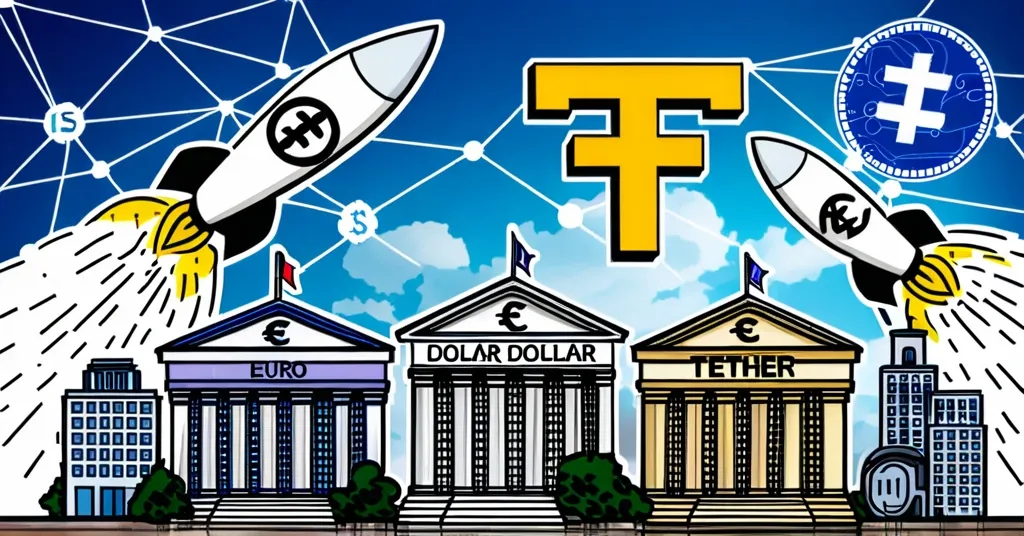Banks Challenge Tether’s Dominance with New Stablecoins, Eyeing $10B Profit

Traditional Banks Dive into Stablecoins, Challenging Tether’s Dominance
With Tether stepping back from its EURt stablecoin, traditional banks are making a bold move into the lucrative stablecoin market, aiming to disrupt Tether’s dominance and capitalize on the $10 billion in profits the industry has seen.
- Tether discontinues EURt due to MiCA regulations
- Banks like SG-Forge launch EURCV for retail investors
- Visa facilitates global stablecoin adoption
- Challenges include liquidity and CBDC competition
The European Union’s Market in Crypto-Assets (MiCA) regulation has provided a clear framework that’s encouraging banks to explore this new frontier. Tether, a leading stablecoin issuer, decided to discontinue its EURt due to these new regulations, leaving a gap in the market. This move has not gone unnoticed, with banks eyeing the lucrative profits that Tether has earned.
Societe Generale-Forge (SG-Forge), a division of the French banking giant, has already launched EURCV, a Euro-backed stablecoin, on the XRP Ledger (XRPL). They’ve opened it up to retail investors, aiming to capitalize on XRPL’s speed, low transaction fees, and scalability. Guillaume Chatain, Chief Revenue Officer at SG-Forge, emphasized the benefits of XRPL, stating, “We chose XRPL for its speed, cost-efficiency, and scalability, which are crucial for our focus on cross-border payments.” While the current market cap of EURCV stands at a modest €38 million, with four wallets controlling 90% of the balance, SG-Forge’s innovative approach to embracing public blockchains is turning heads.
Other banks like Oddo BHF, BBVA, and Revolut are also exploring their versions of euro-denominated stablecoins. AllUnity is gearing up to issue a euro-based stablecoin in 2024, showing the clear intent of traditional finance to not just observe but actively participate in this space.
Visa, the financial services giant, isn’t sitting on the sidelines either. They’ve launched the Visa Tokenized Asset Platform (VTAP), with pilot programs involving banks like BBVA. VTAP is designed to enable financial institutions to create and manage digital tokens backed by fiat currencies, enhancing interoperability across different blockchain networks. Vanessa Colella, Global Head of Innovation and Digital Partnerships at Visa, emphasized their role, saying, “Visa has a long history in digital payments, and we’re committed to helping banks integrate blockchain technologies.”
Outside of Europe, banks in Singapore, Brazil, and Hong Kong are also engaging with Visa’s stablecoin technology. Standard Chartered, for instance, has partnered with Animoca Brands and Hong Kong Telecommunications to issue HKD-denominated stablecoins. Meanwhile, in the United States, banks are biding their time, waiting for similar legislation to MiCA before jumping into the fray.
However, it’s not all smooth sailing. Banks face challenges such as potential impacts on liquidity. Converting retail deposits into stablecoin reserves could weaken their liquidity coverage ratios—a measure of how much money a bank has on hand to cover sudden withdrawals. Francisco Maroto, Head of Blockchain and Digital Assets at BBVA, noted, “We must carefully manage the potential impact on liquidity as we explore new financial products and services through blockchain.”
Moreover, the rise of Central Bank Digital Currencies (CBDCs) looms large, posing direct competition to bank-issued stablecoins. The European Central Bank (ECB) has conducted analyses that highlight these risks, adding another layer of complexity to the banks’ strategies. Yet, the allure of the stablecoin market, with its promise of high profits and the disruption of traditional financial systems, is proving too tempting to ignore.
Even giants like JPMorgan Chase are exploring deposit tokens, which could complement or compete with stablecoins, showing that the interest in this space is not limited to smaller players or those outside the traditional banking system. This aligns with broader trends towards decentralization and financial disruption, challenging the status quo of finance.
Key Takeaways and Questions
- Why are traditional banks entering the stablecoin market?
Traditional banks are entering the stablecoin market to capitalize on Tether’s $10 billion in profits and to fill the gap left by the discontinuation of EURt, facilitated by the clear regulatory framework of MiCA in the EU.
- What impact does the MiCA regulation have on the stablecoin market?
MiCA provides a clear regulatory framework, making it easier for companies and banks to issue stablecoins, thus fostering competition and innovation in the market.
- How are banks outside of the EU responding to stablecoin opportunities?
Banks outside the EU, particularly in the US, are awaiting similar legislation before entering the market, while those in Singapore, Brazil, and Hong Kong are engaging with Visa’s stablecoin technology.
- What challenges do banks face when issuing stablecoins?
Banks face challenges such as potential impacts on liquidity and competition from emerging Central Bank Digital Currencies (CBDCs).
- What role does Visa play in the stablecoin market?
Visa plays a crucial role by launching the Visa Tokenized Asset Platform (VTAP) to ease the issuance of stablecoins and actively engaging with banks globally to facilitate this process.
The stablecoin market is heating up, and traditional banks are not just watching from the sidelines; they’re diving in headfirst. The potential for profit, coupled with the regulatory clarity provided by MiCA, is proving irresistible. Yet, as they navigate this new terrain, they must keep an eye on the liquidity risks and the looming shadow of CBDCs. It’s a wild ride, but one thing’s for sure: the future of finance is being rewritten, and stablecoins are at the heart of it.



